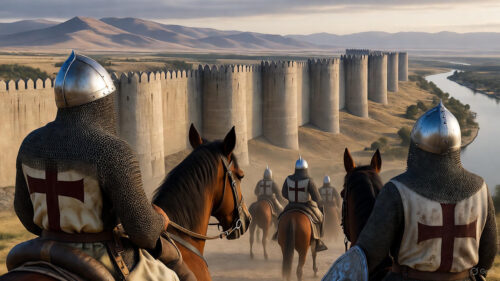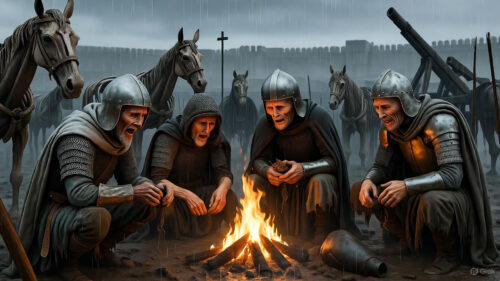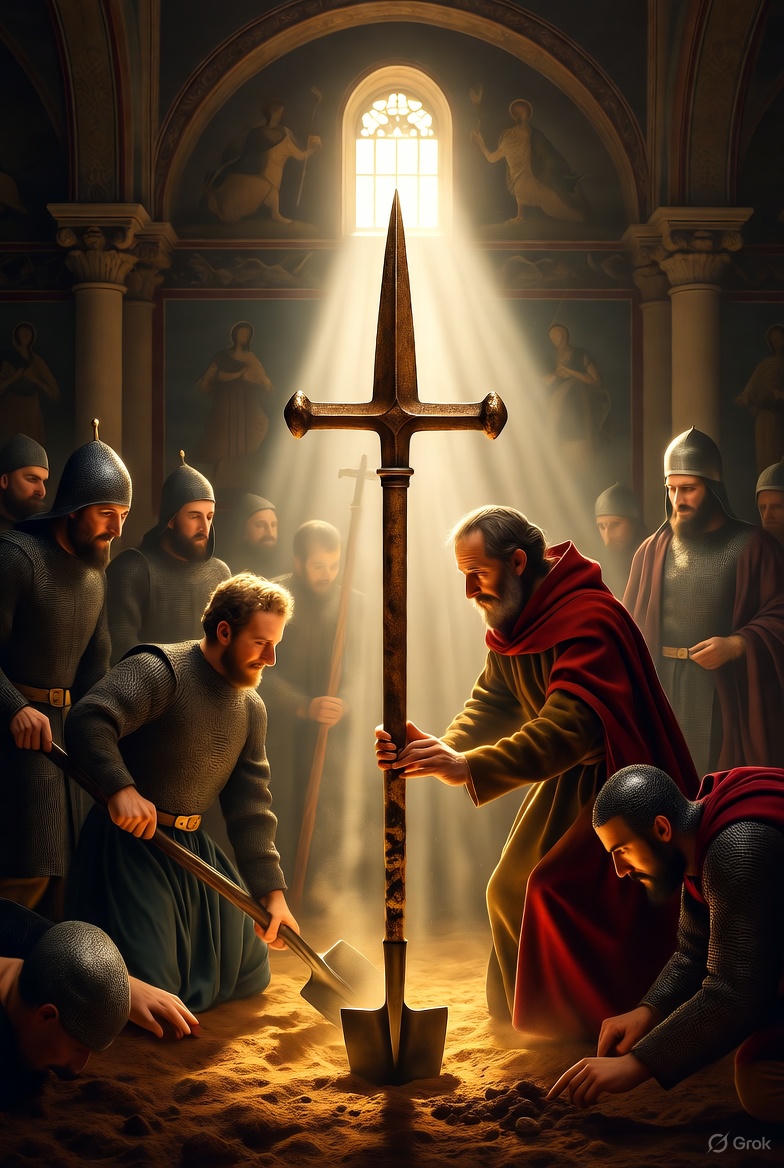Imagine a band of weary warriors, clad in rusted armor, gazing upon towering stone walls that seemed to pierce the heavens. On October 20, 1097, the First Crusaders reached the ancient city of Antioch, marking the beginning of one of the most grueling sieges in medieval history. This wasn’t just a clash of swords and shields; it was a test of human spirit against insurmountable odds, a saga of betrayal, famine, divine intervention, and ultimate triumph that reshaped the course of the Crusades. Today, as we delve into this distant chapter, we’ll uncover the intricate details of that fateful arrival and the months that followed, drawing from chronicles penned by eyewitnesses and historians. But beyond the dust of history, we’ll explore how the lessons from Antioch can ignite your personal journey, turning everyday challenges into opportunities for growth and victory. Buckle up—this is going to be an epic ride through time, packed with facts, drama, and a dash of inspiration.
The First Crusade didn’t start on a whim. It was ignited in November 1095 when Pope Urban II delivered a fiery sermon at the Council of Clermont in France. He called upon Christian knights and common folk alike to reclaim the Holy Land from Muslim control, promising spiritual rewards like the remission of sins. The response was overwhelming. Thousands from across Europe—French, Norman, German, Italian—set off on what they called the “People’s Crusade” or more formally, the Princes’ Crusade, led by noble figures. But the road to Antioch was paved with hardship from the get-go.
The Crusaders’ journey began in earnest in 1096. They crossed vast distances, facing logistical nightmares. Armies numbering in the tens of thousands needed food, water, and supplies, often foraging or relying on local alliances. The Byzantine Emperor Alexios I Komnenos, who had requested Western aid against the Seljuk Turks, provided some support but demanded oaths of fealty for any lands conquered. The Crusaders captured Nicaea in June 1097 after a siege, handing it over to the Byzantines as promised. Then came the Battle of Dorylaeum on July 1, 1097, where they defeated a large Turkish force under Kilij Arslan I, boosting morale but depleting resources.
By autumn, the army splintered slightly for efficiency. One contingent under Baldwin of Boulogne veered off to Edessa, establishing the first Crusader state. The main force, however, pressed toward Antioch, a strategic jewel. Antioch was no ordinary city. Founded in 300 BC by Seleucus I Nicator, one of Alexander the Great’s generals, it had been a crossroads of empires—Roman, Byzantine, Arab, and now under Seljuk Turkish rule since 1085. Its walls, built by Emperor Justinian in the 6th century and reinforced over time, stretched for miles, encompassing mountains and rivers. The city boasted over 400 towers, a citadel on Mount Silpius, and the Orontes River flowing through it, making it a fortress of legend. Yaghi-Siyan, the Turkish governor, had fortified it further, stocking supplies and calling for reinforcements from nearby emirs.
On October 20, 1097, the Crusaders, estimated at around 20,000-30,000 fighting men after losses, crested the hills and beheld Antioch’s imposing silhouette. Chronicles like the Gesta Francorum, written by an anonymous knight, describe the moment with awe: the vast plains, the iron gate, the bridge over the Orontes. The leaders—Godfrey of Bouillon, Bohemond of Taranto, Raymond IV of Toulouse, Robert Curthose of Normandy, and others—quickly assessed the situation. They couldn’t fully encircle the massive city due to its size and terrain, so they set up camps at key points: Bohemond at the northeast near the Gate of St. Paul, Raymond at the south by the Dog Gate, and Godfrey at the west by the Duke’s Gate.
The siege began immediately. Initial assaults were repelled; the walls were too high, the defenders too prepared. Yaghi-Siyan had expelled many Christian inhabitants to prevent internal betrayal but allowed Armenian and Greek Orthodox to stay, hoping for loyalty. The Crusaders built siege engines—catapults, towers, battering rams—but progress was slow. They blocked supply routes, but the city had hidden exits and received occasional aid. As winter set in, the real enemy emerged: famine.
November and December 1097 were brutal. Rain turned camps into mud pits, and food shortages led to starvation. Horses died first, then men resorted to eating leather, roots, and reportedly, in desperation, human flesh—though chroniclers like Fulcher of Chartres debate the extent. Desertions plagued the army; even Peter the Hermit, the charismatic preacher, tried to flee but was brought back. Bohemond and Robert of Flanders led a foraging expedition in December, clashing with a relief force from Damascus at the Battle of Al-Bara, securing some supplies but not enough.
By January 1098, morale plummeted. Yaghi-Siyan launched sorties, killing many. The Crusaders responded by constructing fortifications: a tower called Malregard to block a mountain path, and later La Mahomerie opposite the Bridge Gate. Internal rivalries simmered—Bohemond coveted Antioch for himself, while Raymond advocated for Byzantine oversight.
Spring brought hope and horror. In March, an English fleet under Edgar Atheling arrived at St. Symeon port, bringing materials for more siege towers. The Crusaders built a pontoon bridge over the Orontes and fortified it with Tancred’s Tower. But a massive relief army under Kerbogha, atabeg of Mosul, was assembling, uniting emirs from across the region.
The turning point came through intrigue. Bohemond secretly negotiated with Firouz, an Armenian tower guard disillusioned with Yaghi-Siyan. On the night of June 2-3, 1098, Firouz allowed Bohemond’s men to scale the walls via a ladder. They opened the gates, and the Crusaders poured in, massacring inhabitants in a frenzy. Yaghi-Siyan fled but was killed by locals. The city fell, but the citadel held out under his son.
Barely had the Crusaders claimed victory when Kerbogha’s army, 40,000 strong, arrived on June 7, besieging the besiegers. Now trapped inside Antioch with dwindling supplies, the Crusaders faced starvation again. Visions and portents abounded. A priest named Stephen claimed a vision of Christ promising aid. Then, Peter Bartholomew, a poor pilgrim, announced a vision from St. Andrew revealing the Holy Lance—the spear that pierced Christ’s side—buried in the Church of St. Peter.
On June 14, after digging, they unearthed a lance tip. Whether genuine or planted (historians debate), it electrified the army. Adhemar of Le Puy, the papal legate, was skeptical, but the rank and file saw it as a miracle. Morale soared.
Kerbogha’s forces, though numerous, were divided by rivalries among emirs. On June 28, the Crusaders, inspired by the Lance carried by Raymond of Aguilers, sallied forth in formations. Bohemond commanded the rear guard. The battle raged; Crusaders claimed visions of saints fighting alongside. Kerbogha’s army broke, fleeing in disorder. The citadel surrendered the next day.
The siege cost thousands of lives—perhaps half the Crusader force. Disease claimed Adhemar in August. Disputes over Antioch’s control delayed the march to Jerusalem until 1099. Bohemond eventually kept the city, founding the Principality of Antioch, one of four Crusader states.
Historically, the Siege of Antioch was pivotal. It secured a base for further operations, demonstrated Western military tenacity, and influenced East-West relations for centuries. Chroniclers like Raymond d’Aguilers and Anna Komnene (Byzantine princess) provide vivid accounts, highlighting cultural clashes—Crusaders viewed Turks as barbarians, while Muslims saw them as infidels. The event spurred technological exchanges, like improved siege tactics, and cultural ones, introducing Europe to Eastern luxuries.
But let’s zoom in on lesser-known facets. The role of women: many accompanied the army, nursing, cooking, even fighting. Tatiana, Bohemond’s sister, isn’t mentioned, but figures like Ida of Austria endured hardships. Environmental factors: the 1097-98 winter was unusually harsh, with earthquakes recorded in chronicles. Economic impact: the siege drained resources, leading to inflated prices in nearby markets.
The Armenian community in Antioch played a crucial role. Many sympathized with Christians, providing intelligence. Firouz’s betrayal was motivated by personal grievances—his son held hostage by Yaghi-Siyan. Post-siege, Bohemond integrated locals, marrying an Armenian princess later.
Tactically, the Crusaders adapted. They used mangonels (stone-throwers) and petraries, learned from Byzantines. Kerbogha’s failure stemmed from overconfidence; he didn’t attack immediately upon arrival, allowing Crusaders to recover.
Shifting to the miraculous element, the Holy Lance’s discovery was controversial. Peter Bartholomew underwent a trial by fire to prove his vision but died from burns, casting doubt. The Lance was later carried to Jerusalem but lost to history; several relics claim to be it today.
The siege’s aftermath saw plague outbreaks, further decimating numbers. Yet, it forged alliances; Tancred, Bohemond’s nephew, became a key commander. The event inspired literature, from the Chanson d’Antioche epic to modern novels.
Now, fast-forward nearly a millennium. What can the Siege of Antioch teach us in our fast-paced, modern world? The Crusaders’ story is a masterclass in resilience, where defeat seemed certain multiple times, yet they prevailed through adaptability, unity (albeit fragile), and unyielding belief. The outcome—capturing Antioch—paved the way for Jerusalem’s fall in 1099, altering history. Today, you can harness this spirit to conquer personal “sieges”—be it career setbacks, health struggles, or relationship hurdles. Here’s how this historical triumph translates to your life, with specific, actionable insights.
First, embrace perseverance amid adversity. The Crusaders endured eight months of siege, facing starvation and attacks. In your life:
– When tackling a long-term goal like weight loss, commit to daily small steps—track calories for 30 days straight, even on tough days, mirroring the Crusaders’ daily vigilance.
– In career slumps, set “siege towers” by upskilling weekly; enroll in an online course and complete one module per day, building momentum like constructing Malregard.
Second, leverage unexpected allies and opportunities. Bohemond’s deal with Firouz turned the tide.
– Network intentionally: Attend one industry event monthly, seeking “insiders” who can open doors, just as Firouz did.
– Stay open to pivots: If a project stalls, brainstorm alternative paths daily, like the Crusaders shifting from assault to negotiation.
Third, harness the power of belief and morale boosters. The Holy Lance ignited hope.
– Create personal “relics”: Keep a journal of past wins; review it weekly to fuel motivation during low points.
– Practice visualization: Spend 5 minutes daily imagining success, akin to the visions that spurred the army.
Fourth, manage internal conflicts. Leader rivalries nearly doomed them, but focus on common goals prevailed.
– In team settings, schedule conflict-resolution meetings bi-weekly to align visions.
– Personally, prioritize self-care: Meditate 10 minutes daily to resolve inner doubts.
Fifth, adapt strategies dynamically. From foraging to building bridges, flexibility was key.
– In finances, review budgets monthly and adjust for “relief forces” like unexpected expenses.
– For health, alternate routines—switch workouts if one bores you, keeping engagement high.
Now, a concrete 30-day plan to apply Antioch’s lessons to your life:
– **Days 1-7: Assess Your “Antioch”** – Identify your biggest challenge. Journal details: what’s the “wall” blocking you? Set a clear goal, like the Crusaders’ aim to capture the city.
– **Days 8-14: Build Your Siege Engines** – Gather resources. Research tools or skills needed; take one action daily, e.g., read a chapter on your topic or contact a mentor.
– **Days 15-21: Endure the Famine** – Face hardships head-on. When motivation dips, use a “Holy Lance” ritual—affirmations or a motivational podcast. Track progress to stay inspired.
– **Days 22-28: Seek the Betrayal (Opportunity)** – Look for breakthroughs. Network or experiment with new approaches; one small win can shift everything.
– **Day 29-30: Charge to Victory** – Reflect and celebrate. Adjust the plan for the next cycle, ensuring sustained growth.
The Siege of Antioch reminds us that history isn’t just dates and battles—it’s human stories of grit that echo eternally. By channeling that endurance, you transform obstacles into stepping stones. Who knows? Your personal triumph might inspire others, just as this medieval epic continues to captivate.
But wait, there’s more to the siege’s legacy. It influenced military doctrine; later Crusades adopted similar tactics. Culturally, it spread tales of chivalry, feeding the Arthurian legends. Economically, control of Antioch boosted trade routes, introducing spices and silks to Europe.
In terms of numbers, estimates vary: Crusaders started with 100,000 including non-combatants, dwindled to 20,000 by Antioch’s end. Turkish losses were heavy in the final battle.
The event also highlighted religious fervor’s double edge—motivating but leading to atrocities. Modern historians like Thomas Asbridge in “The First Crusade” detail how it shaped the Middle East’s geopolitics, sowing seeds for ongoing conflicts.
As we wrap this historical deep dive, remember: the past isn’t dead; it’s a toolkit for the present. Apply these lessons, and watch your life siege turn into a saga of success.

